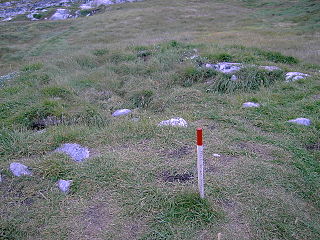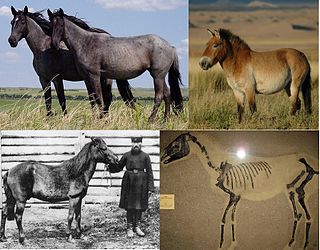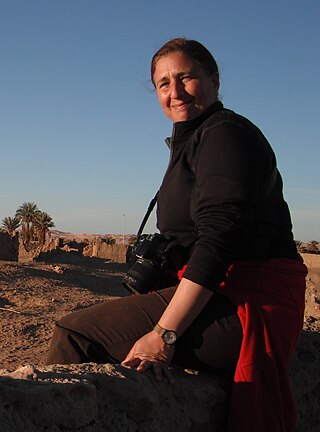Related Research Articles
The Holocene is the current geological epoch. It began approximately 11,700 years before 2000 CE. It follows the Last Glacial Period, which concluded with the Holocene glacial retreat. The Holocene and the preceding Pleistocene together form the Quaternary period. The Holocene has been identified with the current warm period, known as MIS 1. It is considered by some to be an interglacial period within the Pleistocene Epoch, called the Flandrian interglacial.

A mastodon is any proboscidean belonging to the extinct genus Mammut. Mastodons inhabited North and Central America from the late Miocene up to their extinction at the end of the Pleistocene 10,000 to 11,000 years ago.

Beringia is defined today as the land and maritime area bounded on the west by the Lena River in Russia; on the east by the Mackenzie River in Canada; on the north by 72 degrees north latitude in the Chukchi Sea; and on the south by the tip of the Kamchatka Peninsula. It includes the Chukchi Sea, the Bering Sea, the Bering Strait, the Chukchi and Kamchatka Peninsulas in Russia as well as Alaska in the United States and the Yukon in Canada.

Clovis culture is a prehistoric Paleoamerican archaeological culture, named for distinct stone and bone tools found in close association with Pleistocene fauna, particularly two Columbian mammoths, at Blackwater Locality No. 1 near Clovis, New Mexico, in 1936 and 1937, though Paleoindian artifacts had been found at the site since the 1920s. It existed from roughly 11,500 to 10,800 BCE near the end of the Last Glacial Period.

The Greenland Dog is a large breed of husky-type dog kept as a sled dog. They were brought from Siberia to North America by the Thule people 1,000 years ago, along with the Canadian Eskimo Dog. The Canadian Eskimo Dog is considered the same breed as the Greenland Dog since they have not yet diverged enough genetically to be considered separate breeds, despite their geographic isolation.

The Saqqaq culture was a Paleo-Eskimo culture in southern Greenland. Up to this day, no other people seem to have lived in Greenland continually for as long as the Saqqaq.

Beth Alison Shapiro is an American evolutionary molecular biologist. She is a professor in the Department of Ecology and Evolutionary Biology at the University of California, Santa Cruz. Shapiro's work has centered on the analysis of ancient DNA. She was awarded a MacArthur Fellowship in 2009 and a Royal Society University Research Fellowship in 2006.
The Chibanian, widely known as the Middle Pleistocene, is an age in the international geologic timescale or a stage in chronostratigraphy, being a division of the Pleistocene Epoch within the ongoing Quaternary Period. The Chibanian name was officially ratified in January 2020. It is currently estimated to span the time between 0.770 Ma and 0.126 Ma, also expressed as 770–126 ka. It includes the transition in palaeoanthropology from the Lower to the Middle Paleolithic over 300 ka.

The Late Pleistocene is an unofficial age in the international geologic timescale in chronostratigraphy, also known as Upper Pleistocene from a stratigraphic perspective. It is intended to be the fourth division of the Pleistocene Epoch within the ongoing Quaternary Period. It is currently defined as the time between c. 129,000 and c. 11,700 years ago. The Late Pleistocene equates to the proposed Tarantian Age of the geologic time scale, preceded by the officially ratified Chibanian and succeeded by the officially ratified Greenlandian. The estimated beginning of the Tarantian is the start of the Eemian interglacial period. It is held to end with the termination of the Younger Dryas, some 11,700 years ago when the Holocene Epoch began.

Ancient DNA (aDNA) is DNA isolated from ancient specimens. Due to degradation processes ancient DNA is more degraded in comparison with contemporary genetic material. Even under the best preservation conditions, there is an upper boundary of 0.4–1.5 million years for a sample to contain sufficient DNA for sequencing technologies. The oldest sample ever sequenced is estimated to be 1.65 million years old. Genetic material has been recovered from paleo/archaeological and historical skeletal material, mummified tissues, archival collections of non-frozen medical specimens, preserved plant remains, ice and from permafrost cores, marine and lake sediments and excavation dirt. On 7 December 2022, The New York Times reported that two-million year old genetic material was found in Greenland, and is currently considered the oldest DNA discovered so far.

The wild horse is a species of the genus Equus, which includes as subspecies the modern domesticated horse as well as the endangered Przewalski's horse. The European wild horse, also known as the tarpan, that went extinct in the late 19th or early 20th century has previously been treated as the nominate subspecies of wild horse, Equus ferus ferus, but more recent studies have cast doubt on whether tarpans were truly wild or if they actually were feral horses or hybrids.

The Trail Creek Caves are a group of twelve caves found within the Bering Land Bridge National Preserve on the Seward Peninsula of the U.S. state of Alaska. This is a significant archeological site due to the discovery of several artifacts of ancient hunters. These included stone tools and bone fragments dated to 8,500 years or earlier. The caves were discovered in 1928 by Taylor Moto and Alfred Karmun, locals from Deering, Alaska. Geologist David Hopkins tested the site in 1948. This location was first excavated in from 1949-1950 by Danish archeologist Helge Larsen. The caves are located along Trail Creek 65°47′28″N163°24′58″W near its mouth at Cottonwood Creek in the Northwest Arctic Borough.

Sungir is an Upper Paleolithic archaeological site in Russia and one of the earliest records of modern Homo sapiens in Eurasia. It is situated about 200 kilometers (120 mi) of Moscow, on the outskirts of Vladimir, near the Klyazma River. It is dated by calibrated carbon analysis to between 32,050 and 28,550 BCE. Additional pollen finds suggest the relative warm spell of the "Greenland interstadial (GI) 5" between the 30,500 and 30,000 BCE as most probable dates.

Eske Willerslev is a Danish evolutionary geneticist notable for his pioneering work in molecular anthropology, palaeontology, and ecology. He currently holds the Prince Philip Professorship in Ecology and Evolution at University of Cambridge, UK and the Lundbeck Foundation Professorship in Evolution at Copenhagen University, Denmark. He is director of the Centre of Excellence in GeoGenetics, a research associate at the Wellcome Trust Sanger Institute, and a professorial fellow at St John's College, Cambridge. Willerslev is a foreign associate of the National Academy of Sciences (US) and holds the Order of the Dannebrog issued by her Majesty Queen Margrethe II of Denmark in 2017.

The Denisovans or Denisova hominins(di-NEE-sə-və) are an extinct species or subspecies of archaic human that ranged across Asia during the Lower and Middle Paleolithic. Denisovans are known from few physical remains; consequently, most of what is known about them comes from DNA evidence. No formal species name has been established pending more complete fossil material.
Dennis L. Jenkins is a research archaeologist, field school supervisor for the Oregon State Museum of Anthropology/Museum of Natural and Cultural History at the University of Oregon, and director of the university's Northern Great Basin Field School. One of his excavations led to a new accepted date for earliest human settlement in the Americas. Jenkins' work on coprolites earned him the nickname Dr. Poop.
Haplogroup Q-Z780 is a subclade of the Y-DNA Haplogroup Q-L54. Q-Z780 is defined by the presence of the Z780 Single Nucleotide Polymorphism (SNP).

Dr. Marta Mirazón Lahr is a palaeoanthropologist and Director of the Duckworth Laboratory at the University of Cambridge.

In archaeogenetics, the term Ancient North Eurasian (ANE) is the name given to an ancestral component that represents the lineage of the people of the Mal'ta–Buret' culture (c. 24,000 BP) and populations closely related to them, such as the Upper Paleolithic individuals from Afontova Gora in Siberia. The Ancient North Eurasians are deeply related to Paleolithic/Mesolithic hunter-gatherers in Europe. Genetic studies indicate that the ANE are either descendants of the Ancient North Siberians (ANS) represented by two ancient specimens from the preceding Yana Culture (c. 32,000 BP), or that both ANE and ANS are closely, albeit differentiated, sister lineages, which both originated from a shared ancestor of 'Early West Eurasian' hunter-gatherers (represented by Kostenki-14, c. 40,000 BP), which received around 1/4 to 1/3 genetic contribution from an 'Early East Eurasian' population (represented by the Tianyuan man), deeply related to contemporary East/Southeast Asian populations.

The Ancient Beringian (AB) is a specific archaeogenetic lineage, based on the genome of an infant found at the Upward Sun River site, dated to 11,500 years ago. The AB lineage diverged from the Ancestral Native American (ANA) lineage about 20,000 years ago. The ANA lineage was estimated as having been formed between 20,000 and 25,000 years ago by a mixture of East Asian and Ancient North Eurasian lineages, consistent with the model of the peopling of the Americas via Beringia during the Last Glacial Maximum.
References
- ↑ "Statens Naturhistoriske Museum eng – University of Copenhagen". Snm.ku.dk. 3 August 2006. Retrieved 2012-01-25.
- ↑ "Eske Willerslev – University of Copenhagen". Centre for Geogenetics. Retrieved 2012-01-25.
- ↑ "DNA and geological work laboratories". Centre for Geogenetics. Archived from the original on 2012-03-16. Retrieved 2012-01-25.
- ↑ Rasmussen, M; Li, Y; Lindgreen, S; et al. (2010). "Ancient human genome sequence of an extinct Palaeo-Eskimo : Article". Nature. 463 (7282): 757–762. doi:10.1038/nature08835. PMC 3951495 . PMID 20148029.
- ↑ Rasmussen, Morten; et al. (2011). "An Aboriginal Australian Genome Reveals Separate Human Dispersals into Asia". Science Magazine. 334 (6052): 94–98. doi:10.1126/science.1211177. hdl:10072/43493. PMC 3991479 . PMID 21940856.
- ↑ Funder, Svend; Goosse, Hugues; Jepsen, Hans; Kaas, Eigil; Kjær, Kurt H.; Korsgaard, Niels J.; Larsen, Nicolaj K.; Linderson, Hans; Lyså, Astrid; Möller, Per; Olsen, Jesper; Willerslev, Eske (2011-08-05). "A 10,000-Year Record of Arctic Ocean Sea-Ice Variability—View from the Beach". Science. Sciencemag.org. 333 (6043): 747–750. doi:10.1126/science.1202760. PMID 21817051. S2CID 2237936 . Retrieved 2012-01-25.
- ↑ Waters, Michael R.; Stafford, Thomas W.; McDonald, H. Gregory; Gustafson, Carl; Rasmussen, Morten; Cappellini, Enrico; Olsen, Jesper V.; Szklarczyk, Damian; Jensen, Lars Juhl; Gilbert, M. Thomas P.; Willerslev, Eske (2011-10-21). "Pre-Clovis Mastodon Hunting 13,800 Years Ago at the Manis Site, Washington". Science Magazine. 334 (6054): 351–353. doi:10.1126/science.1207663. PMID 22021854. S2CID 26346378 . Retrieved 2012-01-25.
- ↑ Willerslev, Eske; Wang, Jun; Shapiro, Beth; Ludovic, Orlando; et al. (1 July 2013). "Recalibrating Equus evolution using the genome sequence of an early Middle Pleistocene horse". Nature. 499 (7456): 74–78. Bibcode:2013Natur.499...74O. doi:10.1038/nature12323. PMID 23803765. S2CID 4318227 . Retrieved 18 May 2019– via www.nature.com.
- ↑ Featherston, David (7 August 2017). "Publications". Centre for Geogenetics. Retrieved 18 May 2019.
- ↑ Featherston, David (22 August 2016). "Publications". Centre for Geogenetics. Archived from the original on 2 October 2016.